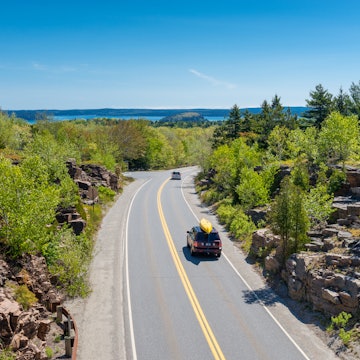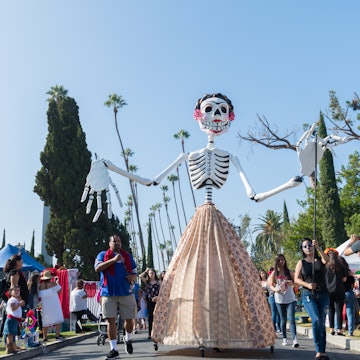

Piercing the city skyline, Paris' icon beckons. karen mandau/Shutterstock
You can experience the iconic Eiffel Tower in Paris in myriad ways, from a daytime trip or an evening ascent amid twinkling lights to a stroll in the gardens at its base. Some seven million people visit annually – it's something that simply has to be done at least once, but no doubt you'll want to return.
Whether you're a Paris regular or visiting for the first time, here's our guide to getting the best from your trip to the Eiffel Tower.
The surprising history of the Eiffel Tower
Named after its designer, Gustave Eiffel, the Tour Eiffel was built for the 1889 Exposition Universelle (World's Fair). It took 300 workers, 2.5 million rivets and two years of nonstop labour to assemble. Upon completion, the 324m-tall (1063ft) tower became the tallest human-made structure in the world – a record it held until 1930, when the Chrysler Building was completed in New York.
A symbol of the modern age, it faced considerable opposition from Paris’ artistic and literary elite, and the "metal asparagus," as some snidely called it, was originally slated to be torn down in 1909. It was spared only because it proved an ideal platform for the transmitting antennas needed for the newfangled science of radiotelegraphy. But Parisians warmed to their iconic tower – today, a popular local nickname for the tower is La dame de fer (Iron Lady).
Sporting six different color schemes during its lifetime, the tower has been painted red and bronze since 1968. The previous 19 coats were stripped off and a yellow-brown shade originally conceived by Gustave Eiffel was applied to give it a new golden hue for the 2024 Olympics.
When should I go to the Eiffel Tower?
The best time of day to visit depends on your itinerary and interests. To have the most varied experience, try to book your visit between late afternoon and dusk. That way, you can start your viewing around sunset and enjoy nighttime views from the top of the tower, before heading across the Seine to admire the twinkly lights that illuminate the tower at night. However, this is also a popular time so if you want to avoid a crowd, head there early or late, after 8pm. The tower closes at 11pm.

How to visit the different levels of the Eiffel Tower
There are three platforms to visit at the Eiffel Tower, accessible via lifts. The lower two levels can also be reached via steps.
Visit the 1st floor cafe and souvenir shop
Of the tower's three levels, the first floor at 57m (187ft) has the most space, with a broad wooden deck for lounging, but the least impressive views. The glass-enclosed Pavillon Ferrié displays an immersive film and there's a small cafe, pizza bar and souvenir shop.
On the outer walkway, you can follow a discovery circuit to learn more about the tower’s ingenious design and history. Check out the sections of glass flooring, offering a dizzying view of the people walking, ant-like, on the ground far below. The 1st floor's commercial areas are powered by two sleek wind turbines enclosed within the tower.
Enjoy fine dining and city views from the 2nd floor
Views from the 2nd floor at 115m (377ft) are grand – impressively high but still close enough to the ground that you can still see the details of the city below. Pinpoint key locations in Paris and beyond using the telescopes and panoramic maps placed around this level.
Windows give an overview of the lifts’ mechanics, and an observation "well" allows you to gaze through glass panels to the ground. Also up here are toilets, souvenir shops, a macaron bar and Michelin-starred Restaurant Le Jules Verne (accessible by a dedicated lift in the south pillar).

Visit the Champagne bar and "secret" apartment on the top floor
Views from the wind-buffeted top floor (276m/906ft) stretch for up to 60km (37 miles) on a clear day. At this height, the sweeping panoramas are more thrilling than detailed. You'll exit the lift onto a glass-enclosed level with directional panels orienting many of the world's cities.
Next, take one of the two small sets of metal stairs to the highest tier, which is open-air. Celebrate your ascent with a glass of bubbly from the Champagne bar at this topmost level – non-drinkers can opt for mineral water, lemonade and macarons. Afterwards, peep into Gustave Eiffel’s restored top-level office, with wax models of Eiffel and his daughter Claire greeting American inventor Thomas Edison. Somewhat unbelievably, there are also toilets up here.
Wander the gardens at ground level
The free-to-visit gardens at the base of the Eiffel Tower are a popular spot to stroll before or after climbing the tower. Redeveloped in 2018, the gardens include water features, trees and shrubs and a belvedere for viewing the ironwork soaring overhead. Enjoy more fresh air and views from the adjacent Parc du Champs de Mars, which runs southeast towards place Joffre and the 18th-century École Militaire.

Queues, tickets and other practicalities
Even on a good day, the base of the Eiffel Tower can be a chaotic scrum of confused travelers. A bit of preparation can cut down on how much time you'll spend joining the fray and waiting in queues, especially in high season (May to September), on weekends, and during holidays such as Easter.
Passing through security
Nowadays, bullet-proof glass barriers surround the tower's base. Visitors must pass through external security checks at one of the two entrances to the glass enclosure on av Gustave Eiffel. The security lines are divided between walk-in visitors, people with pre-booked tickets, and people with reservations at the restaurants.
You are allowed through this point without a ticket if you just want to stroll the gardens directly under the tower itself. When you're ready to leave, the two exits are on quai Branly.
Prebook your tickets
Once inside, there are ticket booths (with long queues) at the south pillar. At certain times, only people with pre-booked tickets will be allowed to get the lift. If there are no lift tickets available, you can usually buy a stairs ticket to access the lower two levels. The views from here are excellent, so don't feel too disappointed if you can't go all the way to the top.
Pre-purchasing tickets online gives you an allocated time slot and means you enter straight away to go through a second security check just before the lift or stairs. Print your ticket, or show it on your phone. Prebooking tickets does not mean you won't spend a good deal of time queuing on your visit! Take note.

Taking the stairs
If you take the stairs, you'll need to climb 360 steps to the 1st floor and another 360 steps to the 2nd floor. At the time of writing, the stairs from the 2nd floor to the top were no longer open to the public. To travel to the top by lift, you'll need to buy a lift ticket at the bottom of the tower or online; it is not possible to buy a ticket for the top on the 2nd floor. Plan for about 10 minutes walking between floors, depending on your fitness level.
Reaching the top-floor by lift
Once you reach the 2nd floor, either on foot or by lift, a separate lift carries visitors up to the top floor. The lift to the top is only accessible by walking up a small flight of stairs to the 2nd-floor mezzanine, where the lift is located.
Note that the top floor and stairs aren't accessible to people with limited mobility. Pushchairs must be folded in lifts and bags or backpacks larger than aeroplane-cabin size aren't allowed. You will need your ticket to access the lift, after, once again, waiting in a queue.
Avoiding the lift queues
A great trick to make the most of your time is to double-check which lift queue is shortest. In the busy swirl, many people are not aware that there are usually two queues for the lifts on each level, both ascending and descending, including on the 2nd-floor mezzanine level.
Most folks unwittingly line up in whichever queue they come to first, but if you're willing to take a quick reconnoiter, you may find the other of the pair of queues on your floor is much shorter. If you're on the 2nd floor, check if the mezzanine queues are shorter – don't follow the herd!
Where to get information on tours and activities
The Eiffel Tower's online visitor's guide is packed with info and can be accessed using the tower's wi-fi network. There's also an information booth at the base, near the west pillar, which has brochures and information on guided tours and activities for kids.

Where can I watch the Eiffel Tower sparkle at night?
Every hour on the hour, the entire tower sparkles brilliantly for five minutes, thanks to 20,000 six-watt bulbs mounted on the ironwork. They were first installed for Paris’ millennium celebration in 2000. It took 25 mountain climbers five months to install the current bulbs, using 40km of electrical cords. For the best view of the light show, head across the Seine to the Jardins du Trocadéro.
Is the Eiffel Tower accessible?
Accessibility has improved at the Eiffel Tower in recent years, although those relying on a wheelchair to get around will still find some challenges. On arrival at the main entrance, you can get in touch with staff who will help you with your visit, granting priority access to lifts where there are long queues. The reception desk for people with reduced mobility is near the West pillar.
Unfortunately, access to the top floor and the stairs to the mezzanine level on the second floor is restricted for anyone with reduced mobility, including those using crutches (in case of the need for a quick evacuation).
How do I get to the Eiffel Tower?
The nearest Metro stop is Bir Hakeim, an eight-minute walk away, while the nearest train station is Champ de Mars–Tour Eiffel (RER C), only a few hundred meters from the tower base. The walk or cycle ride along the Seine to the Eiffel Tower is an enjoyable way to visit, thanks to the city's commendable commitment to reducing car pollution and its riverfront development over the last decade.
Key tips for your visit to the Eiffel Tower
Book tickets well in advance.
Remember that you can ascend as far as the 2nd floor on foot or by lift, but the top floor is only accessible via a separate lift on the 2nd-floor mezzanine.
Check the weather forecast; the lift to the top floor may be closed if it's windy.
At the time of writing, the stairs to the top were closed to the public, so remember to book (or buy at the tower base) a lift ticket to ascend to the top.
Minimize queuing for lifts by descending via the stairs from the 1st or 2nd levels.
Bring a jacket as it can be breezy at the top.
This article was adapted from Lonely Planet’s Experience Paris guidebook, published in June 2024.
















